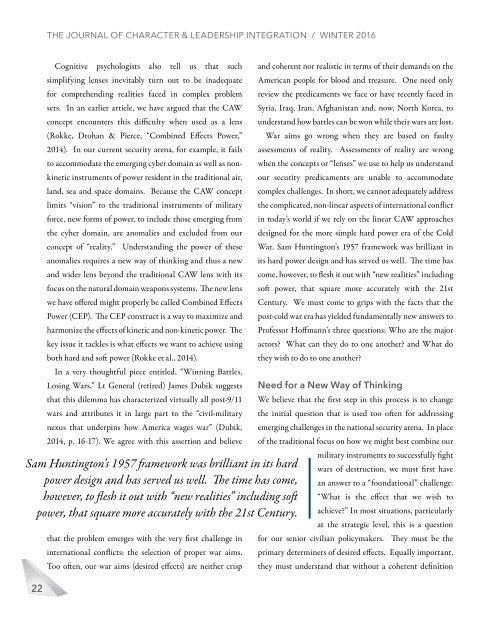PROFESSION OF ARMS
Yi5mwL
Yi5mwL
You also want an ePaper? Increase the reach of your titles
YUMPU automatically turns print PDFs into web optimized ePapers that Google loves.
THE JOURNAL <strong>OF</strong> CHARACTER & LEADERSHIP INTEGRATION / WINTER 2016<br />
22<br />
Cognitive psychologists also tell us that such<br />
simplifying lenses inevitably turn out to be inadequate<br />
for comprehending realities faced in complex problem<br />
sets. In an earlier article, we have argued that the CAW<br />
concept encounters this difficulty when used as a lens<br />
(Rokke, Drohan & Pierce, “Combined Effects Power,”<br />
2014). In our current security arena, for example, it fails<br />
to accommodate the emerging cyber domain as well as nonkinetic<br />
instruments of power resident in the traditional air,<br />
land, sea and space domains. Because the CAW concept<br />
limits “vision” to the traditional instruments of military<br />
force, new forms of power, to include those emerging from<br />
the cyber domain, are anomalies and excluded from our<br />
concept of “reality.” Understanding the power of these<br />
anomalies requires a new way of thinking and thus a new<br />
and wider lens beyond the traditional CAW lens with its<br />
focus on the natural domain weapons systems. The new lens<br />
we have offered might properly be called Combined Effects<br />
Power (CEP). The CEP construct is a way to maximize and<br />
harmonize the effects of kinetic and non-kinetic power. The<br />
key issue it tackles is what effects we want to achieve using<br />
both hard and soft power (Rokke et al., 2014).<br />
In a very thoughtful piece entitled, “Winning Battles,<br />
Losing Wars,” Lt General (retired) James Dubik suggests<br />
that this dilemma has characterized virtually all post-9/11<br />
wars and attributes it in large part to the “civil-military<br />
nexus that underpins how America wages war” (Dubik,<br />
2014, p. 16-17). We agree with this assertion and believe<br />
Sam Huntington’s 1957 framework was brilliant in its hard<br />
power design and has served us well. The time has come,<br />
however, to flesh it out with “new realities” including soft<br />
power, that square more accurately with the 21st Century.<br />
that the problem emerges with the very first challenge in<br />
international conflicts: the selection of proper war aims.<br />
Too often, our war aims (desired effects) are neither crisp<br />
and coherent nor realistic in terms of their demands on the<br />
American people for blood and treasure. One need only<br />
review the predicaments we face or have recently faced in<br />
Syria, Iraq, Iran, Afghanistan and, now, North Korea, to<br />
understand how battles can be won while their wars are lost.<br />
War aims go wrong when they are based on faulty<br />
assessments of reality. Assessments of reality are wrong<br />
when the concepts or “lenses” we use to help us understand<br />
our security predicaments are unable to accommodate<br />
complex challenges. In short, we cannot adequately address<br />
the complicated, non-linear aspects of international conflict<br />
in today’s world if we rely on the linear CAW approaches<br />
designed for the more simple hard power era of the Cold<br />
War. Sam Huntington’s 1957 framework was brilliant in<br />
its hard power design and has served us well. The time has<br />
come, however, to flesh it out with “new realities” including<br />
soft power, that square more accurately with the 21st<br />
Century. We must come to grips with the facts that the<br />
post-cold war era has yielded fundamentally new answers to<br />
Professor Hoffmann’s three questions: Who are the major<br />
actors? What can they do to one another? and What do<br />
they wish to do to one another?<br />
Need for a New Way of Thinking<br />
We believe that the first step in this process is to change<br />
the initial question that is used too often for addressing<br />
emerging challenges in the national security arena. In place<br />
of the traditional focus on how we might best combine our<br />
military instruments to successfully fight<br />
wars of destruction, we must first have<br />
an answer to a “foundational” challenge:<br />
“What is the effect that we wish to<br />
achieve?” In most situations, particularly<br />
at the strategic level, this is a question<br />
for our senior civilian policymakers. They must be the<br />
primary determiners of desired effects. Equally important,<br />
they must understand that without a coherent definition


